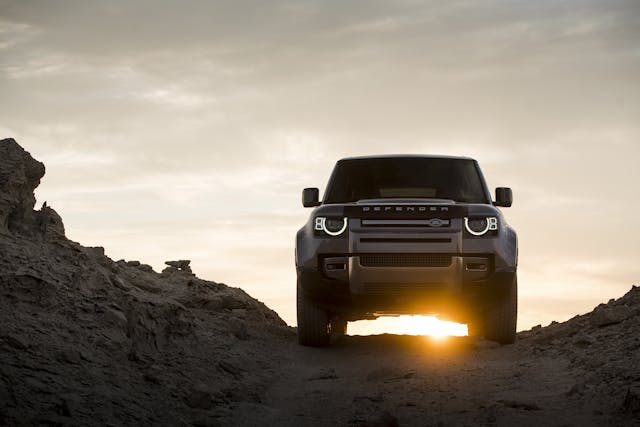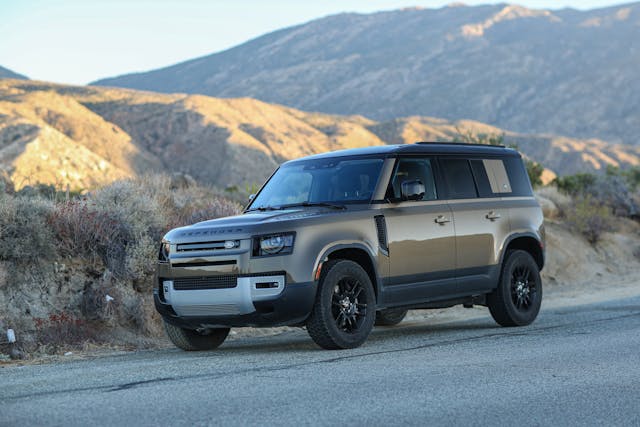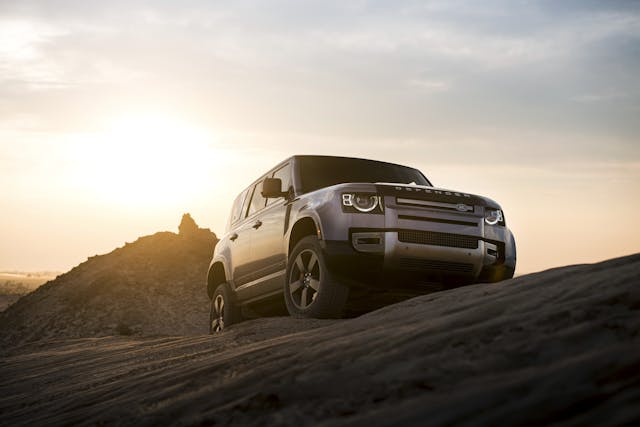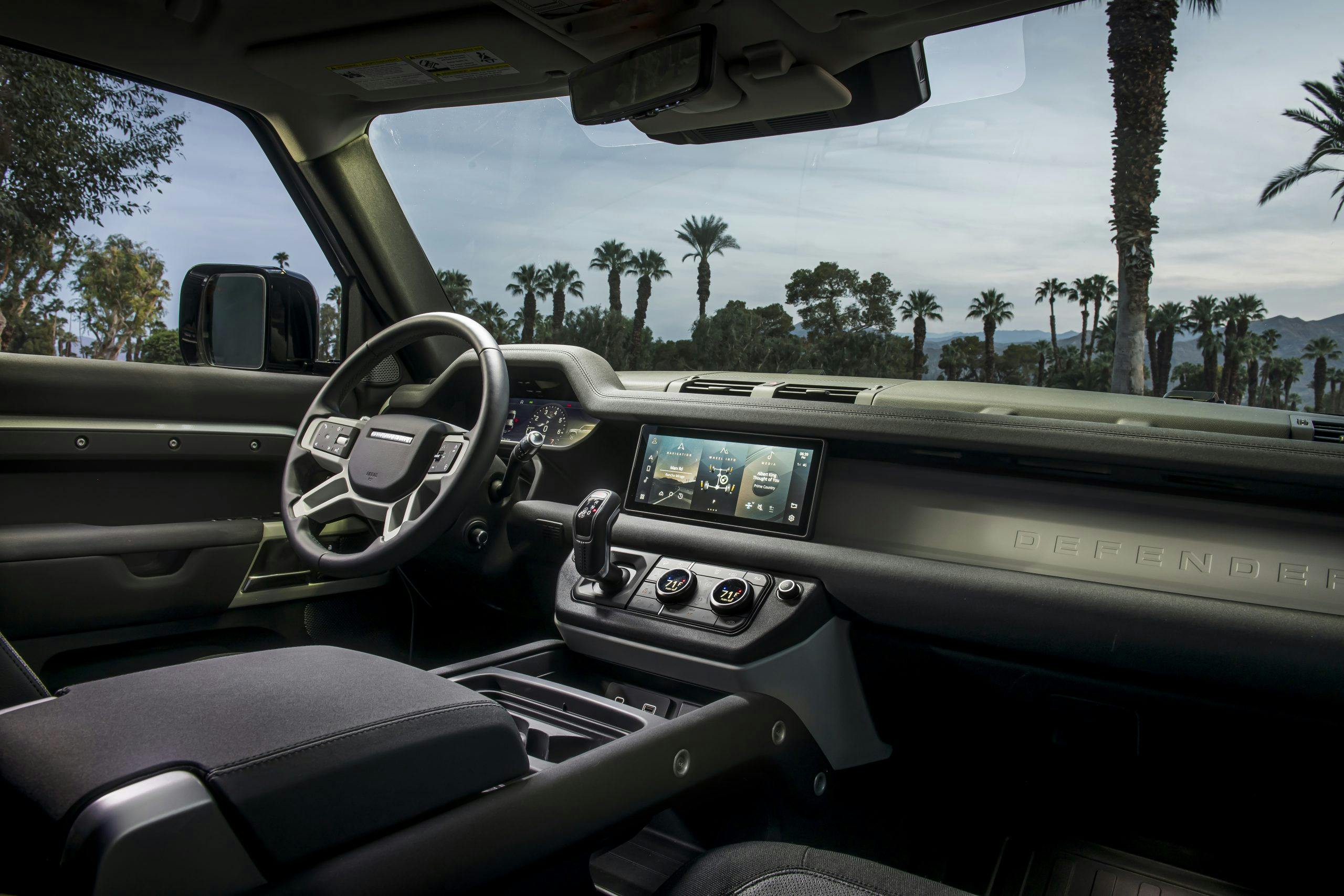Review: 2020 Land Rover Defender 110 SE
After more than 20 years of absence, Land Rover brought the Defender back to the U.S. late this year. When the previous (and, until recently, only) Defender left the U.S. market there were plenty of options for buyers looking for a rugged off-road SUV with a real four-wheel-drive system and a low-range transfer case. The list of offerings that have come and gone—or that have just gone—in that time is lengthy: Montero, Trooper, Blazer, Xterra, Cherokee, Commander … Thankfully, Land Rover saw fit to bring this one back, but it’s not quite the same blocky, utilitarian workhorse it once was.

In a bid to target “younger, modern customers,” Land Rover totally redesigned the Defender and the current generation marks the single biggest jump in the evolution of the standard Land Rover product to date. It now features four-wheel-independent suspension and unibody construction based on a highly modified version of the Discovery’s underpinnings it calls D7x. Production has been slow to ramp up due to 2020’s COVID-19 pandemic, so we patiently waited until recently to get behind the wheel of one for the first time in North America.
With the supply chain up and running, Land Rover invited us to the California desert south of Palm Springs where we’d have exclusive access to a single 2020 Land Rover Defender 110 SE finished in Gondwana Stone. It’s not that we’re special; each of the invited members of the media also got exclusive access to their own Defender 110 SE, owing to social distancing guidelines. Like all SE models, ours was powered by the twin-charged 3.0-liter inline-six with its 24V mild hybrid system and carried a base MSRP of $62,250. With the optional paint color ($710), adaptive cruise control ($1020), Advanced Off-Road Capability Pack ($735), Off-Road Pack ($1345), panoramic roof ($1750), various blacked-out trim and roof panel ($1470), and the cold climate pack with its heated windshield, steering wheel, and windshield washer ($700), the total climbed to $72,780 including destination.
Our first impression upon sliding behind the wheel of the new Defender is that it seemed bigger than we’d expected. Land Rover noted that it would be cross-shopped by someone considering everything from a Wrangler or a Tahoe. The Defender seemed more comfortable than the former and less roomy than the latter. There aren’t too many buttons in the center stack and the shifter is located in a decently sized center console that is surprisingly lacking in storage space in the main compartment. Chalk that up to the fact that it’s insulated, and that it doubles as a refrigerator in models equipped with the optional seat coolers, which this model did not have. Thankfully there are plenty of other places in the console to stash cups and there’s a conveniently located wireless charging pad. We appreciated the clean overall design of the interior that’s centered around a simple, horizontal dash highlighting its magnesium construction. There are lots of exposed fasteners and the exterior color is visible around the perimeter of the door trim, a visual link to the Defenders of the past.
The infotainment screen for Defender uses an all-new operating system. The configurable instrument panel can display the audio selection, trip info, navigation, and various gauge selections, including a center digital tachometer surrounding the speedometer that allows for those aforementioned details to sit on each flank. The wide touch screen above the center stack can also display a treble of selections and operates with just a hint of lag. A pair of large knobs in the center stack handle multiple functions of the HVAC and Terrain Response. This took a bit of getting used to, as several functions required a button press before the knob toggled to the intended function. A two-day test of the vehicle isn’t enough time to get used to any of these functions, but it may be something that becomes second nature.

Our Defender was equipped with the optional 255/65/R19 off-road tires which are a part of the Off-Road Pack along with its electronic active differential. We didn’t sample the standard 20-inch tire, although the 19s were still quite planted on the windy mountain roads we experienced on our highway climb from Palm Springs to Idyllwild and back again. On-road performance is everything you’d expect from a modern crossover: minimal body roll, precise steering, and little to no tire or wind noise with plenty of warning that the tires are being pushed at the limit.
As mentioned, the Defender we had for both our on-road and off-road adventures was the same 110 SE. Its 3.0-liter inline-six brought 395 hp and moves the Defender briskly through an eight-speed automatic. Some of our fellow participants noted some powertrain hesitation; we felt the engine’s electric supercharger spooled up almost instantaneously. The turbocharger takes over soon after. The result is a flat torque curve with decent responsiveness that’s short of a sports car but absolutely within reason for a vehicle of its type.

As with all vehicles save for those with inordinately long front doors (like two-door coupes), taller drivers may find their shoulders close to the B-pillar in the Defender. This wasn’t an issue when we were on the highway, stretched out into a comfortable driving position. When we went off-road, we decided to tilt the seat to a more vertical position and also slide it up a bit. Our off-road excursion had us rolling back and forth over whoops and bumps that would have had us banging into the pillar otherwise. It’s par for the course when trail riding and the wide footwell gave us plenty of room for alternate seating positions.
Speaking of seating positions, the underside of the Defender is relatively smooth, lacking any kind of low-hanging hardware to snag on the trail. What does that have to do with seating? All of those under-chassis bits have to go somewhere, resulting in a step up in the floorboard just aft of the driver footwell. Drivers who prefer to sit close to the wheel may never notice it, taller drivers may use it as a footrest in lieu of a dead pedal.

Naturally, it’s the off-road portion of our test where the Defender shone, especially for a vehicle that was so composed on the pavement. While there are heavy-duty, solid-axle, mammoth-tire methods for conquering off-road obstacles, Land Rover nowadays takes a “finesse” approach for the more technical aspects of off-roading. The firm’s Terrain Response system combines with an adjustable air suspension to increase ground clearance and maximize traction. It also improves the already impressive approach, departure, and break-over angles.
Most of the off-road ride, led by a small team of Land Rover’s off-road instructors, took place through desert trails filled with whoops and washes that could have been traversed by any decent crossover with a modicum of ground clearance. However, several steep dips into ravines and a rugged wash highlighted the nimble maneuverability of the Defender.

In one such portion, we were able to test the rock-crawling mode that locks the differentials and remaps the throttle, making it far less sensitive. Forward-facing cameras in the side mirrors and grille can act as the next best thing to a spotter on the trail, helping you place the tires properly on obstacles. An optional view even stitches the three camera views together and continues to display the object even as they leave the camera’s field of view, giving the driver a simulated view of what is underneath the vehicle. A solid axle vehicle may have more articulation in the above-pictured scenario, but with locking differentials providing power to all tires regardless, lifting a wheel off the trail isn’t guaranteed to end in an axle without any propulsion. The Defender slowly ambled its way over the obstacles with no fuss, emitting just a few audible clicks from some solenoids in the dash. It was decidedly less dramatic than what we heard when crawling in the Tacoma TRD Pro.

Toward the end of our off-road excursion, we had the chance to pilot the Defender onto some dunes in California’s Superstition Hills. The fine desert sand can be a test of driver skill, and we admit we’ve been stuck in sand before, but the Defender’s Sand Mode helped by raising shift points and keeping the throttle from slamming shut when letting off the pedal. Maintaining momentum is important, but so is having fun, so Land Rover relaxed the stability control to allow more yaw before interrupting drifting in Sand Mode. When left in normal “Comfort” mode there’s definitely more interference on the throttle. The terrain selection works.
With its $62,250 starting price, Defender is well above Jeep’s Wrangler and on par with the top Bronco trim level, the sold-out First Edition. Many of the options in our SE could be skipped without any loss of function, including its paint color, roof color, and blacked-out trim. While the panoramic sunroof does offer better views for rear-seat passengers, that’s also a pricey proposition. Our tester did not come with air-conditioned seats, which we tend to appreciate but didn’t really miss despite the desert setting. Skip a few of the cosmetic add-ons and the sticker price seems right in line with some of its larger, less off-road friendly competition.
2020 Land Rover Defender 110 SE: $72,780 as tested.
Highs: Still very functional off-road and highly customizable. Strong powertrain, better ride quality than any Defender before.
Lows: There’s a learning curve for operating the infotainment, it looks more like a Discovery than the Defender we’re used to, and lane-keep assist is intrusive on windy roads.
Summary: For buyers who want off-road credibility and comfort, the Defender offers a compelling case and a package size that might lure some full-size shoppers. If it’s too much car for your wallet or trails, the two-door 2021 Defender 90 will be on its way shortly.





